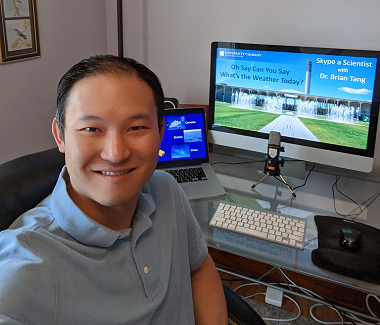Atmospheric Scientist Virtually Inspires Next Generation of STEM Leaders
With more than 55 million children across the U.S. forced into a distance learning model, educators are taking creative approaches to keep their students engaged during the COVID-19 crisis – including a guest appearance from a UAlbany atmospheric scientist.
Department of Atmospheric and Environmental Sciences (DAES) Associate Professor Brian Tang is part of the “Skype a Scientist” program. The non-profit virtually matches scientists with classrooms around the globe to share insight about their profession and interact with students.
Since 2017, more than 7,000 scientists from around the world in fields ranging from psychology to meteorology have been paired with over 14,000 classrooms through the program.
“I signed up last semester thinking it would be a neat way to do outreach with students that we usually would not have an opportunity to engage with,” Tang said. “Then, the pandemic hit, and before I knew it, I was getting requests from teachers both near and far.”
Tang has booked five guest presentations so far, all with fifth and sixth graders in public school systems. Three classrooms were in New York City; two in Orlando.
Each of his presentations (of about 40 minutes) focus on a weather topic of interest to the students, such as: Why are clouds important? What are the ingredients to make heavy rain? How do hurricanes form? What are tornados? The final 20 minutes are reserved for students, along with parents and other teachers, to ask their own questions about the weather and what it is like to be a scientist.
“Joining this program has been great practice for remembering how to speak to your audience,” Tang said. “As professors, we’re used to communicating with other researchers and our students at the college level. This has been a new and rewarding challenge.”
“Some of the classrooms I have been matched with so far have been in disadvantaged areas. Speaking to them about STEM topics in a way that relates to their experiences can have a powerful result.”
Tang plans to continue with the program, even after students are allowed back into the classroom. He encourages other scientists at UAlbany (including graduate students and post-doc associates) who are interested to fill out a volunteer form here.
“The big impact is worth the small commitment,” Tang said. “You’re talking to classes of 20 to 40 students, sometimes more, without leaving your home. The outreach quickly adds up. It’s a great way to help inspire our next generation of scientists.”





